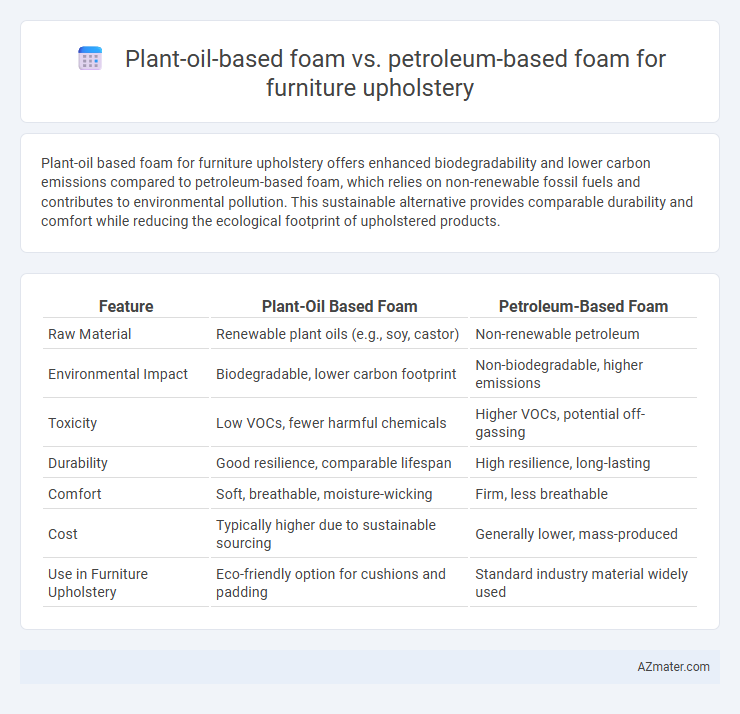Plant-oil based foam for furniture upholstery offers enhanced biodegradability and lower carbon emissions compared to petroleum-based foam, which relies on non-renewable fossil fuels and contributes to environmental pollution. This sustainable alternative provides comparable durability and comfort while reducing the ecological footprint of upholstered products.
Table of Comparison
| Feature | Plant-Oil Based Foam | Petroleum-Based Foam |
|---|---|---|
| Raw Material | Renewable plant oils (e.g., soy, castor) | Non-renewable petroleum |
| Environmental Impact | Biodegradable, lower carbon footprint | Non-biodegradable, higher emissions |
| Toxicity | Low VOCs, fewer harmful chemicals | Higher VOCs, potential off-gassing |
| Durability | Good resilience, comparable lifespan | High resilience, long-lasting |
| Comfort | Soft, breathable, moisture-wicking | Firm, less breathable |
| Cost | Typically higher due to sustainable sourcing | Generally lower, mass-produced |
| Use in Furniture Upholstery | Eco-friendly option for cushions and padding | Standard industry material widely used |
Introduction to Plant-Oil and Petroleum-Based Foams
Plant-oil based foams, derived from renewable resources such as soy or castor oil, offer a sustainable alternative to traditional petroleum-based foams used in furniture upholstery. These bio-based foams provide comparable durability, resilience, and comfort while reducing reliance on fossil fuels and lowering environmental impact. Petroleum-based foams, made from non-renewable crude oil, have long been the standard for upholstery due to their cost-effectiveness and consistent performance but pose challenges related to biodegradability and carbon footprint.
Chemical Composition and Source Materials
Plant-oil based foam for furniture upholstery primarily consists of polyurethane derived from renewable sources such as soy, castor, or palm oils, offering a sustainable alternative to traditional petroleum-based foams made from fossil fuels like crude oil. The chemical composition of plant-oil foams includes bio-based polyols, which reduce reliance on petrochemicals and often provide enhanced biodegradability and lower volatile organic compound (VOC) emissions. In contrast, petroleum-based foams contain petrochemical-derived polyols and isocyanates, contributing to higher environmental impact and limited renewable content in upholstery applications.
Environmental Impact and Sustainability
Plant-oil based foam for furniture upholstery significantly reduces carbon footprint by utilizing renewable resources and enhancing biodegradability compared to petroleum-based foam, which relies on finite fossil fuels and contributes to long-term pollution. The adoption of bio-based foams supports circular economy principles by minimizing hazardous chemical use and enabling better end-of-life recycling options. Sustainable plantations and responsible sourcing of plant oils further amplify environmental benefits by preserving biodiversity and reducing land degradation associated with petroleum extraction.
Performance and Durability Comparison
Plant-oil based foam offers comparable resilience and comfort to petroleum-based foam while providing enhanced environmental benefits through bio-based materials. Its cellular structure maintains consistent performance under prolonged compression, exhibiting similar density and support retention as traditional polyurethane foams. Durability tests show plant-oil foam resists degradation and maintains shape over extended use, making it a sustainable yet effective alternative for furniture upholstery.
Comfort and Aesthetic Qualities
Plant-oil based foam offers superior breathability and resilience, enhancing comfort by maintaining temperature regulation and reducing pressure points during extended use. Its natural composition allows for smoother texture and a more consistent cell structure, resulting in aesthetically pleasing furniture upholstery with improved durability and softness. Petroleum-based foam, while traditionally used, typically lacks the same level of moisture management and may degrade faster, leading to diminished comfort and visual appeal over time.
Cost Analysis and Market Trends
Plant-oil based foam for furniture upholstery offers a competitive cost advantage due to lower raw material price volatility compared to petroleum-based foam, which is subject to crude oil price fluctuations. Market trends indicate growing demand for sustainable and eco-friendly materials, driving increased adoption of plant-oil based foams, supported by government incentives and consumer awareness. Despite higher initial production costs, plant-oil foams benefit from expanding market share and favorable regulatory frameworks, suggesting long-term cost-effectiveness and industry growth.
Health and Safety Considerations
Plant-oil based foam for furniture upholstery offers significant health advantages by reducing exposure to volatile organic compounds (VOCs) and harmful chemicals commonly found in petroleum-based foams. These bio-based foams release fewer toxic emissions during use and disposal, minimizing indoor air pollution and allergen risks. Choosing plant-oil foam enhances occupant safety by supporting better air quality and reducing the potential for respiratory irritation and chemical sensitivities.
Manufacturing Processes and Innovations
Plant-oil based foam for furniture upholstery leverages renewable resources like soy and castor oils, incorporating bio-polyols that enable eco-friendly manufacturing through lower energy consumption and reduced volatile organic compounds emissions. Innovations in catalyst technology and polymerization methods enhance the foam's durability, resilience, and comfort, providing comparable performance to traditional petroleum-based foams. In contrast, petroleum-based foam relies on non-renewable petrochemicals, involving energy-intensive processes and releasing higher greenhouse gas emissions during production, making plant-oil based foam a more sustainable and innovative alternative in furniture manufacturing.
Industry Adoption and Consumer Preferences
Plant-oil based foam is gaining traction in the furniture upholstery industry due to its sustainability, biodegradability, and lower carbon footprint compared to traditional petroleum-based foam, which remains dominant due to cost efficiency and established manufacturing processes. Consumer preferences are increasingly shifting toward eco-friendly furniture options, driving demand for plant-oil based foam products that offer comparable comfort and durability with a reduced environmental impact. Industry adoption is accelerating as manufacturers respond to both regulatory pressures and market trends favoring renewable materials in sustainable furniture production.
Future Prospects for Furniture Upholstery Foams
Plant-oil based foams, derived from renewable resources such as soy, castor, and palm oils, offer sustainable alternatives to conventional petroleum-based foams in furniture upholstery, significantly reducing carbon footprint and dependence on fossil fuels. Innovations in bio-polyol formulations enhance durability, comfort, and fire resistance, positioning plant-oil foams as viable competitors with improved environmental profiles. Growing consumer demand for eco-friendly products and stricter environmental regulations are expected to drive rapid adoption and continual advancements in plant-oil based upholstery foams over the next decade.

Infographic: Plant-oil based foam vs Petroleum-based foam for Furniture upholstery
 azmater.com
azmater.com